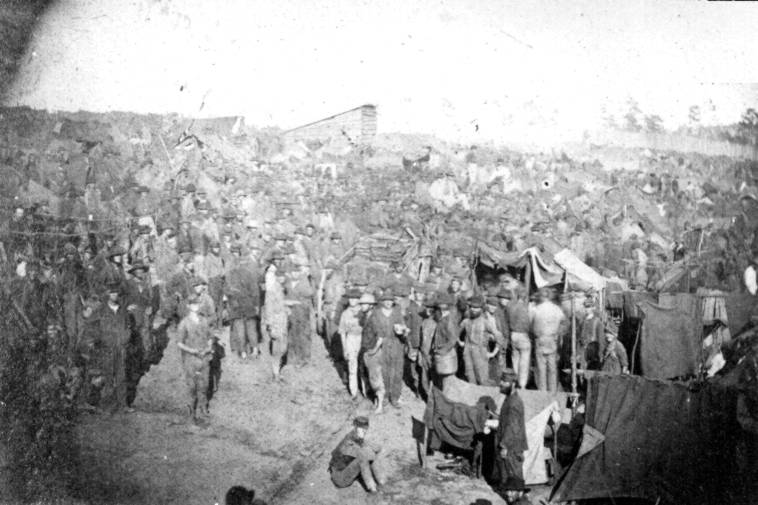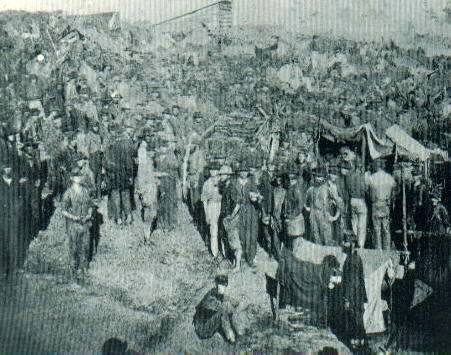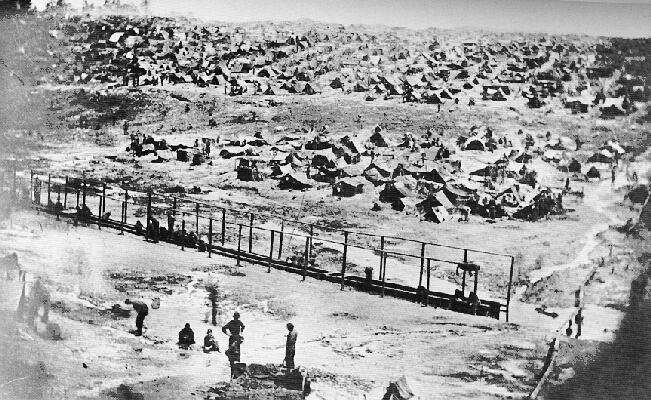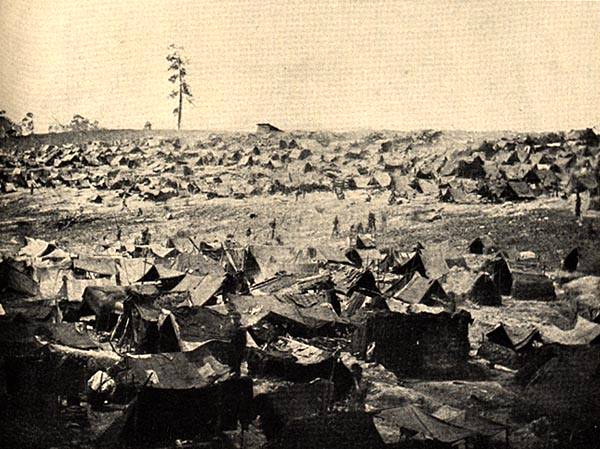June 1864 through May 1865
Andersonville, or Camp Sumter as it was officially known, was one of the largest of many established prison camps during the American Civil War. It was built early in 1864 after Confederate officials decided to move the large number of Federal prisoners kept in and around Richmond, Virginia, to a place of greater security and a more abundant food supply. During the 14 months the prison existed, more than 45,000 Union Solders were confined here. Of these, almost 13,000 died from disease, poor sanitation, malnutrition, overcrowding, or exposure to the elements.
The 23rd Pennsylvania Volunteers had nine men who were captured during the Civil War and sent to Andersonville Prison. Of those nine, four of them would die there and lie there in Andersonville National Cemetery. This page is dedicated to those nine men who served faithfully and were placed in "Hell on Earth" for over a year.


Conditions Worsen
The pen initially covered about 16 1/2 acres of land enclosed by a 15 foot high stockade of hewn pine logs. It was enlarged to 26 1/2 acres in June of 1864. The stockade was in the shape of a parallelogram 1,620 feet long and 779 feet wide. Sentry boxes, or "pigeon roost" as the prisoners called them, stood at 30 yard intervals along the top of the stockade. Inside, about 19 feet from the wall, was the " DEADLINE ," which the prisoners were forbidden to cross upon threat of death. Flowing through the prison yard was a stream called Stockade Branch, which supplied water to most of the prison. Two entrances, the North Gate and the South Gate, were on the West side of the stockade. Eight small earthen forts located around the exterior of the prison were equipped with artillery to quell disturbances within the compound and to defend against feared Union cavalry attacks. The first prisoners were brought to Andersonville in February, 1864. During the next few months approximately 400 more arrived each day until, by the end of June, some 26,000 men were confined in a prison area originally intended to hold 13,000. The largest number held at any one time was more than 32,000- about the population of present-day Sumter County- in August, 1864. Handicapped by deteriorating economic conditions, an inadequate transportation system, and the need to concentrate all available resources on the army, the Confederate government was unable to provide adequate housing, food, clothing, and medical care to their Federal captives. These conditions, along with a breakdown of the prisoner exchange system, resulted in much suffering and a high mortality rate.

 Never before or since has there been such a prison as Andersonille. Though many Northern and Southern Prisons were in bad condition or run poorly, Andersonville by the numbers was by far the worst. It resulted in the execution of Captain Henry Wirz who was brought to trail with many witnesses and former prisoners who testified against him. He would be the only person charged with war crimes.
Never before or since has there been such a prison as Andersonille. Though many Northern and Southern Prisons were in bad condition or run poorly, Andersonville by the numbers was by far the worst. It resulted in the execution of Captain Henry Wirz who was brought to trail with many witnesses and former prisoners who testified against him. He would be the only person charged with war crimes.
Andersonville Prison ceased to exist in May, 1865. Some former prisoners remained in Federal service, but most returned to the civilian occupations they had before the war. During July and August, 1865, Clara Barton, a detachment of laborers and soldiers, and a former prisoner named Dorence Atwater, came to Andersonville cemetery to identify and mark the graves of the Union dead. As a prisoner, Atwater was assigned to record the names of deceased Union soldiers for the Confederates. Fearing loss of of the death record at war's end, Atwater made his own copy in hopes of notifying the relatives of some 12,000 dead interred at Andersonville. Thanks to his list and the Confederate records confiscated at the end of the war, only 460 of the Andersonville graves had to be marked " Unknown U.S. Soldier."
Thanks to Kevin Frye for his help with research on the 23rd PA at Andersonville Prison. He can be reached at:
Kevin Frye: frye@pstel.net
Credits
The information to put this write-up together was taken from the following sources:
Andersonville "Story of Southern Prisons" John McElroy 1879
Andersonville MacKinlay Kantor 1955
Giving up The Ghost "A Collection of Prisoners Diaries,Letters and Memoirs" Belle Grove 1996
“Life of the 23rd Pennsylvania “Birney’s Zouaves” ,William J. Wray 1904, 1999,2004
Kevin Frye
Research and Studies of Frank P. Marrone Jr.
Losses
9 Men Captured and sent to Andersonville.
4 Died
Pvt. Albert Thalheimer of Company B who was imprisoned and survived Andersonville, returned to the Prison in 1905 for cerimonies for the dedication of a memorial. After the War he lived at 36 North 11th Street in Reading , Berks County, Pennsylvania.
In 1996 Turner Pictures released a movie about the Andersonville experience entitled "Andersonville". It is 167 minutes long and availible on DVD and Video.

"Andersonville" The Movie (Click for more info)
Losses
75 Killed
124 Wounded
5 Captured (Sent to Andersonville)



